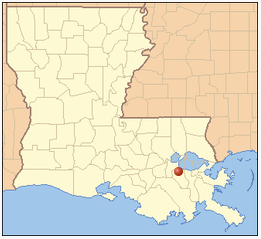| Home | Search | Emissions | Pollutants | About the Database |

Valero (26003), Norco
LDEQ Accident Report
| Accident # | 131415 |
| State Police # | 11-02970 |
| Accident Date | 2011-05-20 |
| Report Date | 2011-05-27 |
| Follow-up Date | 2011-07-19 |
| Follow-up: | Yes |
Pollutants Released
| Pollutant | Duration | Point Source | Greenhouse Gas | Criteria Pollutant | Ozone forming chemical | Amount of Release |
| Sulfur Dioxide | 17 h | 30, 3700, and1600 Unit Thermal Oxiders, Flares 1 and 2 | NO | YES | NO | 12,495.4 pounds |
| Nitrogen Oxide | 17 h | 1600 TOX and Flares 1 and 2 | NO | YES | YES | 1,215.0 pounds |
| Volatile Organic Compounds (VOCs) | 17 h | 1600 TOX and flares 1 and 2 | NO | NO | YES | 7,334.2 pounds |
| Carbon Monoxide | 17 h | 1600 TOX and Flares 1 and 2 | NO | YES | NO | 783.5 pounds |
| Particulate Matter 10 | 17 h | 1600 TOX and Flares 1 and 2 | NO | YES | NO | 100.3 pounds |
| Benzene | 17 h | Flares 1 and 2 | NO | NO | YES | 72.9 pounds |
| Hydrogen Sulfide | 17 h | 30, 3700, and1600 Unit Thermal Oxiders, Flares 1 and 2 | NO | NO | NO | 4,128.5 pounds |
| Propylene | 17 h | Flares 1 and 2 | NO | NO | YES | 21.0 pounds |
Accident Classified As: Reportable Quantity
Cause of Problem: Process Upset
Due to multiple equipment high levels during startup of the Gasoline Desulfurizing Unit (GDU), hydrocarbons were introduced into the refinery's sulfur dioxide removal system and to the Sulfur Recovery Units (SRU) feeds resulting in unit upsets. Sulfur dioxide levels at the 1600, 3700 and 30 Unit Thermal Oxidizers were elevated from 3:24 pm on 5/20/11 until 8:00 am on 5/21/11. This caused smoking from the 1600 TOX stack from approximately 3:55 until 4:10 and the unit was shut down during this time. The 3700 and 30 Unit TOXs were also shutdown at approximately 3:40 and 4:13 respectively. Additionally, these process upsets also impacted the refinery's fluid catalytic cracking unit resulting in flaring for portions of this incident.
Discharge Preventable - Yes
This incident was reasonably preventable.
Notes/Remedial Actions
Valero did not show their limit for SO2, CO, NOx, PM, and VOC in the Thermal Oxidizer and flarecap. No limit was shown for Benzene in the Thermal Oxidizer. No limit was shown for H2S and Propylene in the flarecap. Accurate estimates could not be made. All values are below the total emitted and may be grossly deflated. During the event Valero received an odor complaint and took action to prevent and minimize any public nuisance. Field monitoring did not reveal any detectable quantities of VOCs or sulfur dioxide. Operational moves were made to the sulfur recover plants to shutdown the thermal oxidizers safely. Operators maximized steam to the refinery flares to mitigate visible emissions. During the incident fence-line monitoring was conducted by Valero and there were no detectable concentrations found. The following corrective actions were identified to prevent recurrence of this incident: (1) Modify the startup procedure for the GDU to ensure a shift supervisor monitors the unit radio channel (2) Include in the SRU standing orders that amine upsets be communicated to the shift supervisor and the shift superintendent (3) Modify GDU SOP's to amplify actions required for the amine system (4) Configure a separate console to receive all GDU alarms (5) Implement alarm management to allow high priority alarms to be flagged (6) Consider installing an auto shut off on the amine absorbers bottoms plant wide (7) Consider installing a bypass on the feed to untreated gasoline storage to improve feed control to the GDU during start up (8) Train the SRU operators on the rich DEA flash drum weir configurations. The hydrogen sulfide and sulfur dioxide permitted rates and reportable quantities were exceeded. There were released of nitric oxide, benzene, and VOCs released above reportable quantities. Opacity and visible emission limits were exceeded for flares 1 and 2 and the GRP007 SRU/TOCAP-SRU TO/CAP. The SRU sulfur dioxode concentration limit (250 ppm/ 12 h) for 30 and 1600 Unit TOXs and the EP and WP Fuel Gas hydrogen sulfide (162 ppm/3 h) were also exceeded.

Connect With Us: